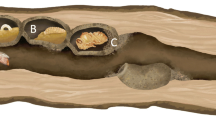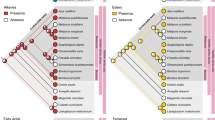Abstract
Chemical communication is crucial for the maintenance of colony organization in eusocial insects and chemical signals are known to mediate important aspects of their social life, including the regulation of reproduction. Sociality is therefore hypothesized to be accompanied by an increase in the complexity of chemical communication. However, little is known about the evolution of odor signals at the transition from solitary living to eusociality. Halictid bees are especially suitable models to study this question as they exhibit considerable variability in social behavior. Here we investigated whether the dissimilarities in cuticle chemical signals in females of different castes and life stages reflect the level of social complexity across halictid bee species. Our hypothesis was that species with a higher social behavior ergo obligate eusocial species possess a more distinct chemical profile between castes or female life stages. We analyzed cuticular chemical profiles of foundresses, breeding females and workers of ancestrally solitary species, facultative and obligate eusocial halictid species. We also tested whether social complexity was associated with a higher investment in chemical signals. Our results revealed higher chemical dissimilarity between castes in obligate than in facultative eusocial species, especially regarding macrocyclic lactones, which were the single common compound class overproduced in queens compared with workers. Chemical dissimilarities were independent of differences in ovarian status in obligate eusocial species but were dependent on ovarian status in facultative eusocial species, which we discuss in an evolutionary framework.





Similar content being viewed by others
References
Ayasse M, Engels W, Hefetz A, Tengö J, Lübke G, Francke W (1993) Ontogenetic patterns of volatiles identified in Dufour's gland extracts from queens and workers of the primitively eusocial halictine bee, Lasioglossum malachurum (Hymenoptera: Halictidae). Insect Soc 40:41–58. https://doi.org/10.1007/BF01338831
Ayasse M, Marlovits T, Tengö J, Taghizadeh T, Francke W (1995) Are there pheromonal dominance signals in the bumblebee Bombus hypnorum L (Hymenoptera, Apidae)? Apidologie 26:163–180. https://doi.org/10.1051/apido.19950301
Ayasse M, Engels W, Lübke G, Taghizadeh T, Francke W (1999) Mating expenditures reduced via female sex pheromone modulation in the primitively eusocial halictine bee, Lasioglossum (Evylaeus) malachurum (Hymenoptera: Halictidae). Behav Ecol Sociobiol 45:95–106. https://doi.org/10.1007/s002650050543
Ayasse M, Paxton R, Tengö J (2001) Mating behaviour and chemical communication in the order Hymenoptera. Annu Rev Entomol 46:31–78
Blomquist GJ, Bagnères A-G (2010) Insect hydrocarbons: biology, biochemistry, and chemical ecology. Cambridge University Press, Cambridge
Blum MS (1996) Semiochemical parsimony in the Arthropoda. Annu Rev Entomol 41:353–374. https://doi.org/10.1146/annurev.en.41.010196.002033
Brady SG, Sipes S, Pearson A, Danforth BN (2006) Recent and simultaneous origins of eusociality in halictid bees. Proc R Soc B 273:1643–1649. https://doi.org/10.1098/rspb.2006.3496
Cane JH (1981) Dufour's gland secretion in the cell linings of bees (Hymenoptera: Apoidea). J Chem Ecol 7:403–410. https://doi.org/10.1007/bf00995762
Clarke KR, Gorley RN (2006) PRIMER V6: user manual-tutorial. Plymouth Marine Laboratory, Plymouth
Danforth BN (2002) Evolution of sociality in a primitively eusocial lineage of bees. Proc Natl Acad Sci 99:286–290. https://doi.org/10.1073/pnas.012387999
Dapporto L, Matthew Sledge F, Turillazzi S (2005) Dynamics of cuticular chemical profiles of Polistes dominulus workers in orphaned nests (Hymenoptera, Vespidae). J Insect Physiol 51:969–973. https://doi.org/10.1016/j.jinsphys.2005.04.011
Dietemann V, Peeters C, Liebig J, Thivet V, Hölldobler B (2003) Cuticular hydrocarbons mediate discrimination of reproductives and nonreproductives in the ant Myrmecia gulosa. Proc Natl Acad Sci 100:10341–10346. https://doi.org/10.1073/pnas.1834281100
Duchateau MJ, Velthuis HHW (1989) Ovarian development and egg laying in workers of Bombus terrestris. Entomol Exp Appl 51:199–213. https://doi.org/10.1111/j.1570-7458.1989.tb01231.x
Duffield RM, Fernandes A, Lamb C, Wheeler JW, Eickwort GC (1981) Macrocyclic lactones and isopentenyl esters in the Dufour's gland secretion of halictine bees (Hymenoptera: Halictidae). J Chem Ecol 7:319–331. https://doi.org/10.1007/bf00995755
Francke W (2010) Structure elucidation of some naturally occurring carbonyl compounds upon coupled gas chromatography/mass spectrometry and micro-reactions. Chemoecology 20:163–169. https://doi.org/10.1007/s00049-010-0048-0
Gibbs J, Brady SG, Kanda K, Danforth BN (2012) Phylogeny of halictine bees supports a shared origin of eusociality for Halictus and Lasioglossum (Apoidea: Anthophila: Halictidae). Mol Phylogenet Evol 65:926–939. https://doi.org/10.1016/j.ympev.2012.08.013
Hefetz A (1987) The role of Dufour's gland secretions in bees. Physiol Entomol 12:243–253. https://doi.org/10.1111/j.1365-3032.1987.tb00749.x
Hefetz A, Bergström G, Tengö J (1986) Species, individual and kin specific blends in Dufour's gland secretions of halictine bees. J Chem Ecol 12:197–208. https://doi.org/10.1007/BF01045603
Holman L (2012) Costs and constraints conspire to produce honest signaling: insights from an ant queen pheromone. Evolution 66:2094–2105. https://doi.org/10.1111/j.1558-5646.2012.01603.x
Holman L, Lanfear R, d'Ettorre P (2013) The evolution of queen pheromones in the ant genus Lasius. J Evol Biol 26:1549–1558. https://doi.org/10.1111/jeb.12162
Holman L, Hanley B, Millar JG (2016) Highly specific responses to queen pheromone in three Lasius ant species. Behav Ecol Sociobiol 70:387–392. https://doi.org/10.1007/s00265-016-2058-6
Hothorn T, Bretz F, Westfall P (2008) Simultaneous inference in general parametric models. Biom J 50:346–363. https://doi.org/10.1002/bimj.200810425
Howard RW, Blomquist GJ (2005) Ecological, behavioral, and biochemical aspects of insect hydrocarbons. Annu Rev Entomol 50:371–393. https://doi.org/10.1146/annurev.ento.50.071803.130359
Johansson I, Svensson BG, Tengö J, Bergström G (1982) Systematic relationship of halictinae bees based on the pattern of macrocyclic lactones in the Dufour gland secretion. Insect Biochem 12:161–170. https://doi.org/10.1016/0020-1790(82)90004-X
Kather R, Martin SJ (2015) Evolution of cuticular hydrocarbons in the Hymenoptera: a meta-analysis. J Chem Ecol 41:871–883. https://doi.org/10.1007/s10886-015-0631-5
Keller L, Nonacs P (1993) The role of queen pheromones in social insects: queen control or queen signal? Anim Behav 45:787–794. https://doi.org/10.1006/anbe.1993.1092
Kocher SD, Grozinger CM (2011) Cooperation, conflict, and the evolution of queen pheromones. J Chem Ecol 37:1263–1275. https://doi.org/10.1007/s10886-011-0036-z
Kocher SD, Paxton RJ (2014) Comparative methods offer powerful insights into social evolution in bees. Apidologie 45:289–305. https://doi.org/10.1007/s13592-014-0268-3
Le Conte Y, Hefetz A (2008) Primer pheromones in social Hymenoptera. Annu Rev Entomol 53:523–542. https://doi.org/10.1146/annurev.ento.52.110405.091434
Leonhardt SD, Menzel F, Nehring V, Schmitt T (2016) Ecology and evolution of communication in social insects. Cell 164:1277–1287. https://doi.org/10.1016/j.cell.2016.01.035
Liebig J, Peeters C, Oldham NJ, Markstädter C, Hölldobler B (2000) Are variations in cuticular hydrocarbons of queens and workers a reliable signal of fertility in the ant Harpegnathos saltator? Proc Natl Acad Sci 97:4124–4131. https://doi.org/10.1073/pnas.97.8.4124
Liebig J, Eliyahu D, Brent CS (2009) Cuticular hydrocarbon profiles indicate reproductive status in the termite Zootermopsis nevadensis. Behav Ecol Sociobiol 63:1799–1807. https://doi.org/10.1007/s00265-009-0807-5
Monnin T (2006) Chemical recognition of reproductive status in social insects. Ann Zool Fenn 43:515–530
Monnin T, Ratnieks FLW, Jones GR, Beard R (2002) Pretender punishment induced by chemical signalling in a queenless ant. Nature 419:61–65. https://doi.org/10.1038/nature00932
Oi CA, van Zweden JS, Oliveira RC, Van Oystaeyen A, Nascimento FS, Wenseleers T (2015) The origin and evolution of social insect queen pheromones: novel hypotheses and outstanding problems. BioEssays 37:808–821. https://doi.org/10.1002/bies.201400180
Oksanen J, Guillaume Blanchet F, Friendly M, Kindt R, Legendre P, McGlinn D, Minchin PR, O'Hara RB, Simpson GL, Solymos P, Henry M, Stevens H, Szoecs E, Wagner H (2017) Vegan: community ecology package. R package version 2.4–3. https://CRAN.R-project.org/package=vegan
Peeters C, Liebig J (2009) Fertility signaling as a general mechanism of regulating reproductive division of labor in ants. In: Gadau J, Fewell J (eds) Organization of insect societies: from genome to socio-complexity. Harvard University Press, Cambridge, pp 220–242
Peeters C, Monnin T, Malosse C (1999) Cuticular hydrocarbons correlated with reproductive status in a queenless ant. Proc R Soc B Biol Sci 266:1323–1327. https://doi.org/10.1098/rspb.1999.0782
R Core Team (2016) R: a language and environment for statistical computing R Foundation for statistical computing, Vienna, Austria. URL https://www.R-project.org/
Schwarz MP, Richards MH, Danforth BN (2007) Changing paradigms in insect social evolution: insights from Halictine and Allodapine bees. Annu Rev Entomol 52:127–150. https://doi.org/10.1146/annurev.ento.51.110104.150950
Smith AA, Liebig J (2017) The evolution of cuticular fertility signals in eusocial insects. Curr Opin Insect Sci 22:79–84. https://doi.org/10.1016/j.cois.2017.05.017
Smith B, Weller C (1989) Social competition among gynes in halictine bees: the influence of bee size and pheromones on behavior. J Insect Behav 2:397–411. https://doi.org/10.1007/BF01068064
Smith BH, Carlson RG, Frazier J (1985) Identification and bioassay of macrocyclic lactone sex pheromone of the halictine bee Lasioglossum zephyrum. J Chem Ecol 11:1447–1456. https://doi.org/10.1007/bf01012144
Smith AA, Millar JG, Hanks LM, Suarez AV (2012) Experimental evidence that workers recognize reproductives through cuticular hydrocarbons in the ant Odontomachus brunneus. Behav Ecol Sociobiol 66:1267–1276. https://doi.org/10.1007/s00265-012-1380-x
Smith AA, Millar JG, Suarez AV (2016) Comparative analysis of fertility signals and sex-specific cuticular chemical profiles of Odontomachus trap-jaw ants. J Exp Biol 219:419–430. https://doi.org/10.1242/jeb.128850
Soro A, Ayasse M, Zobel MU, Paxton RJ (2009) Complex sociogenetic organization and the origin of unrelated workers in a eusocial sweat bee, Lasioglossum malachurum. Insect Soc 56:55–63. https://doi.org/10.1007/s00040-008-1037-y
Soro A, Ayasse M, Zobel MU, Paxton RJ (2011) Kin discriminators in the eusocial sweat bee Lasioglossum malachurum: the reliability of cuticular and Dufour’s gland odours. Behav Ecol Sociobiol 65:641–653. https://doi.org/10.1007/s00265-010-1066-1
Sramkova A, Schulz C, Twele R, Francke W, Ayasse M (2008) Fertility signals in the bumblebee Bombus terrestris (Hymenoptera: Apidae). Naturwissenschaften 95:515–522. https://doi.org/10.1007/s00114-008-0353-4
Stökl J, Steiger S (2017) Evolutionary origin of insect pheromones. Curr Opin Insect Sci 24:36–42. https://doi.org/10.1016/j.cois.2017.09.004
Van Oystaeyen A, Oliveira RC, Holman L, van Zweden JS, Romero C, Oi CA, d'Ettorre P, Khalesi M, Billen J, Wäckers F, Millar JG, Wenseleers T (2014) Conserved class of queen pheromones stops social insect workers from reproducing. Science 343:287–290. https://doi.org/10.1126/science.1244899
van Zweden J, d'Ettorre P (2010) Nestmate recognition in social insects and the role of hydrocarbons. In: Blomquist GJ (ed) Insect hydrocarbons biology, biochemistry, and chemical ecology. Cambridge University Press, pp 222–243
Wcislo WT, Danforth BN (1997) Secondary solitary: the evolutionary loss of social behavior. Trends Ecol Evol 12:468–474
Wilson EO (1971) The insect societies. Belknap Press of Harvard University Press, Cambridge
Wittwer B, Hefetz A, Simon T, Murphy LEK, Elgar MA, Pierce NE, Kocher SD (2017) Solitary bees reduce investment in communication compared with their social relatives. Proc Natl Acad Sci 114:6569–6574. https://doi.org/10.1073/pnas.1620780114
Wyatt TD (2014) Pheromones and animal behavior: chemical signals and signatures. Cambridge University Press, Cambridge
Acknowledgements
The authors thank Antonella Soro, Bill Wcislo and Beryl Jones for their helpful collaboration and collection of samples, Laura Campos for assistance in collecting and analyzing some of the data and Jonas Kuppler as well as two anonymous reviewers and Etya Ansalem for helpful comments on the manuscript. We acknowledge Stefan Schulz for his help in structure elucidation. Callum Kingwell was funded by scholarships from the Natural Sciences and Engineering Research Council of Canada (NSERC) and the Smithsonian Tropical Research Institute (STRI) and Iris Steitz by a scholarship from the Studienstiftung des Deutschen Volkes.
Author information
Authors and Affiliations
Corresponding author
Ethics declarations
Conflict of Interest
The authors declare that they have no conflict of interest.
Electronic supplementary material
ESM 1
(PDF 1305 kb)
Rights and permissions
About this article
Cite this article
Steitz, I., Kingwell, C., Paxton, R.J. et al. Evolution of Caste-Specific Chemical Profiles in Halictid Bees. J Chem Ecol 44, 827–837 (2018). https://doi.org/10.1007/s10886-018-0991-8
Received:
Revised:
Accepted:
Published:
Issue Date:
DOI: https://doi.org/10.1007/s10886-018-0991-8




